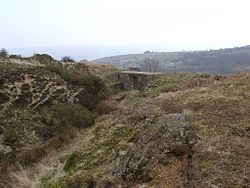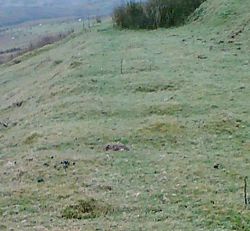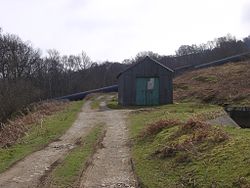- Cowlyd Tramway
-
Cowlyd Tramway Locale Wales Dates of operation c. 1916–c. 1968 Track gauge 2 ft (610 mm) Length 4 miles (6.4 km) Headquarters Dolgarrog The Cowlyd Tramway was a narrow gauge 2 ft (610 mm) gauge railway line used to convey men and materials to Llyn Cowlyd Reservoir, near Trefriw in North Wales during the enlargement of the dam, and thereafter for maintenance purposes.
Contents
History
Llyn Cowlyd had been a reservoir since 1908, owned by the Conwy and Colwyn Bay Joint Water Supply Board. By 1915 rights to water extraction were also held by the Aluminium Corporation and the North Wales Power and Traction Co. Ltd., both of Dolgarrog, and a severe drought in this year prompted the decision to increase water reserves by building a much higher dam.
Construction of the Cowlyd Tramway began in 1916, and reached Llyn Cowlyd the following year. The dam was completed in December 1921, being built entirely from rock quarried from the adjacent mountainside, and was opened the following year in more favourable weather.
The tramway was essentially a branch line of the former Eigiau Tramway, built originally as a standard gauge tramway to serve Llyn Eigiau, and connected to the works at Dolgarrog by a series of rope-worked inclines which ran down the steep Dolgarrog escarpment.
The Eigiau Tramway was itself a successor to the narrow gauge Cedryn Quarry Tramway. At the time of the construction of the Cowlyd Tramway the Eigiau Tramway was re-gauged to the same narrow gauge so that the same locomotives could be used on both. After the collapse of the Eigiau dam in 1925, and the closure of that tramway, the inclines were only used by the Cowlyd Tramway.
Route
From the top of the Dolgarrog inclines, near Coedty (where it branched from the Eigiau Tramway), the line ran for some 4 miles largely parallel to, and to the north of Afon Ddu. To the north-west lie the slopes of Moel Eilio, and to the south-east is the ridge of Cefn Cyfarwydd. The line ran up to Llyn Cowlyd dam, where it ended in two sidings and a loop.
About a mile above Coedty the tramway passed over the workings of the former Ardda sulphur and lead mine. Little remains of the smithy and office today. A tramway, built in 1853, and the earliest in the area, ran for a little over half a mile before descending an incline to the walled mine yard beside Pont Dolgarrog and the former Royal Oak Inn, now called the "Lord Newborough" after the landowner. By 1864 this tramway had closed.
The line for most of its length runs to the south of the water pipeline. However, it finished at the northern end of the dam, which means that at some point it must have passed below it, and this is evident between Siglen and the dam, where the pipe has a 'hump' to afford the necessary clearance.
Locomotives
Two steam engines were used on the line during construction of the dam – the German built loco Eigiau (Orenstein & Koppel, No. 5668 of 1913, latterly at Penrhyn Quarry, and a Bagnall 0-4-0ST, Works No.2080 of 1918.
Upon completion of the dam, and with only maintenance work being envisaged, Eigiau was taken off, pending sale, and a Simplex diesel loco, Motor Rail 22154 Dolgarrog was acquired in 1922. This was later used in the 1970s to lay power cables alongside the Llanberis Lake Railway, this being followed by a spell on display in the Dolgarrog Power Station Museum, together with some wagons from the tramway.
"Dolgarrog" is currently on loan from Innogy – owners of Dolgarrog Power station, and in whose colours it is painted – and is being used by the revived Welsh Highland Railway in the reconstruction of the narrow gauge line from Caernarfon to Porthmadog. This loan to the WHR is not without precedent – back in 1922/3 the original Welsh Highland construction contractors also made use of a steam locomotive which had previously been used here, namely the Bagnall.
In 1936 a new diesel tractor was acquired, a Simplex (Hibbert, No.1988 of 1936) and this was replaced by new Motor Rail tractor, No.22154 of 1962.
Closure
The tramway closed temporarily in 1968 after a derailment of a workmen's train, but in fact it never re-opened as it was deemed unsafe. The approach road from Trefriw, which had been extended in the mid-1960s anyway to a point close to the pipeline, was now simply extended further so that necessary vehicles could reach the reservoir. This resulted in some destruction of the former tramway route. It is reported that insufficient time and money had been spent on the construction of the line, which was of generally poor quality, and that maintenance after construction was also minimal.[1].
Remains
Today the whole route of the line between Coedty and Llyn Cowlyd is clearly evident. Where the metalled Trefriw access road ends at the gate, at Siglen, the route of the line between here and the dam runs higher up than the current dam access track, meaning that much of the formation has largely been untouched, and therefore much can be seen in the way of trackbed remains, including sleepers and rail. It is also apparent from these remains that the formation was, indeed, in places, of minimal standard.
In the other direction, between Siglen and Coedty, the formation has been widened to form an access track (for farm and pipeline vehicle access) and on these widened sections the rail has been recovered, leaving only minimal evidence of the line. Today the whole length of the tramway can easily be walked, particularly between Siglen and the top of the Dolgarrog inclines. It will be seen that the formation was of better construction towards Coedty, where there is an embankment and some small cuttings.
The loco shed is still evident close to the top of the highest incline, near the point where the Cowlyd tramway branched off the Eigiau tramway. Unlike the lower inclines, this one has not subsequently been utilized by the pipepines running down to Dolgarrog. At its head is an abandoned corrugated iron winding shed, a replacement for an earlier one.
It is commonly held that the rail used on some of the cattle-grids on the Trefriw to Cowlyd access road came from the former tramway, but comparison of the two reveals clearly that the tramway rail was considerably lighter, and would not be sufficiently heavy for this later use. It is more likely that it came from the Eigiau tramway, which at one time carried standard gauge engines, and would have been laid in heavier rail.
See also
External links
References
- ^ Boyd, James I.C. (1988). Narrow Gauge Railways in North Caernarvonshire: Volume Three. The Oakwood Press. ISBN 0-85361-365-6.
Categories:- Narrow gauge railways in Wales
- 2ft gauge railways
- Railway lines opened in 1917
Wikimedia Foundation. 2010.











